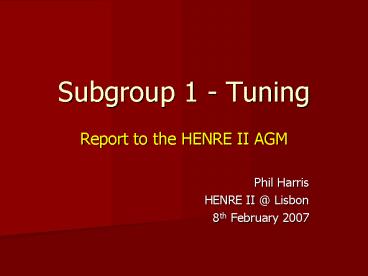Subgroup 1 Tuning - PowerPoint PPT Presentation
1 / 16
Title:
Subgroup 1 Tuning
Description:
Work in a multidisciplinary healthcare team and effectively apply verbal ... 4. During the diagnostic or therapeutic procedure, apply ethical principles ... – PowerPoint PPT presentation
Number of Views:43
Avg rating:3.0/5.0
Title: Subgroup 1 Tuning
1
Subgroup 1 - Tuning
- Report to the HENRE II AGM
- Phil Harris
- HENRE II _at_ Lisbon
- 8th February 2007
2
What is Tuning? a reminder
- Tuning is an integral part of the Bologna
process which aims to create freedom of movement
for students and academic staff throughout Europe
beyond.
3
Aim
- To provide general guidelines so that
Universities of all 45 Bologna countries can
communicate in an agreed language and share basic
structures e.g. Cycles, Credits, Quality
Procedures etc.
4
Aim
- To make Bologna a word which means
- Quality
- Transparency
- Recognition
- Employability
- Mobility
5
Subgroup 1 Objectives
- To make recommendations regarding the nature of
radiographic education programmes across Europe
within the higher education sector - Identify and recommend minimum learning outcomes
of radiographic programmes of study at first
cycle level - Identify descriptors and benchmarks for
radiographic education in order to develop
academic and professional profiles for European
Radiographers - Facilitate interaction and integration for the
Eastern and central European region.
6
Groups responses to objective 1
- Work ongoing to analyse data collected from over
100 institutions as part of the HENRE I project. - This work compared generic competencies and
subject specific competencies amongst newly
qualified radiographers
7
HENRE TUNING of Radiographic competencies within
the European Union
8
Generic questions Part 1
- GENERIC SKILLS
- A programme of medical imaging and radiotherapy
study should - include the following academic competences
- 1. A capacity for analysis and synthesis
- 2. A capacity for applying knowledge in practice
- 3. A capacity to reflect on experience in
practice - 4. An ability to plan and time manage ones own
workload - 5. Possess general knowledge in field of
study - 6. Possess a grounding of knowledge of the
profession in practice - 7. Be able to communicate orally and written in
your native language - 8. Possess knowledge of a second language
- 9. Possess an appropriate understanding of I.T.
skills - 10. Demonstration of an awareness of research and
its use
9
HENRE TUNING of Radiographic competencies within
the European Union
10
Subject specific questions Part 2
- The newly qualified radiographer should be able
to - 1. Work in a multidisciplinary healthcare team
and effectively apply verbal - and non-verbal communication with patients
and others. - 2. Inform and instruct patients appropriately
before, during and after - procedures.
- 3. Document, communicate and report information
in a coherent way while - complying with data protection regulations.
- 4. During the diagnostic or therapeutic
procedure, apply ethical principles - and obtain informed consent according to
professional standards. - 5. Practice according to national and Local
health and safety protocols. - 6. Accept responsibility for ones own actions
within the scope of - professional practice.
- 7. Evaluate the needs of patients in various
circumstances and apply - appropriate care.
- 8. Strategically plan and manage ones own work
load and work flow.
11
Groups responses to objective 1
- It was anticipated that courses at first cycle
would be different throughout Europe because of
the range of ECTS credits required for
qualification but. - The differences could also be due to the ECTS
system being used or interpreted differently
12
Groups responses to objective 1
- It is obviously necessary to distinguish between
the two elements above therefore. - A further piece of work was initiated which asked
institutions to compare their course Learning
Outcomes (or similar) to a single set of National
Benchmarks - This work was initiated following the last
subgroup meeting in September with a deadline for
completion of 31st Jan 2007
13
Groups responses to objective 2
- (Identify and recommend minimum learning outcomes
of radiographic programmes of study at first
cycle level) - It was felt that the recent work which has been
started i.e. the comparison of Learning Outcomes
for individual institutions against a benchmark
should answer this Objective
14
Groups responses to objective 3
- (Identify descriptors and benchmarks for
radiographic education in order to develop
academic and professional profiles for European
Radiographers) - Again, the information we are seeking above for
objectives 1 2 was thought appropriate to
answer this question - Additionally, because National Benchmarks were
thought not to be available for all countries
involved, the UK QAA benchmarks could be used as
an initial measure
15
Groups responses to objective 4
- (Facilitate interaction and integration for the
Eastern and central European region) - It was felt by the group that the potential
benefits for all radiographers in Europe were
great in terms of freedom of movement - The benefits for those from Eastern European and
New Member countries was potentially greater in
the immediate sense, because the comparability
study could offer some advantages for work
throughout the currently better off states.
16
There is no more except the questions!
- (which I shall look to my fellow subgroup
members to help me answer)































